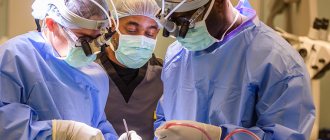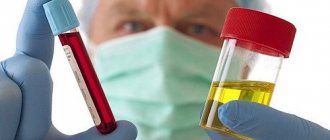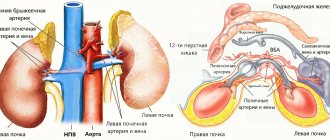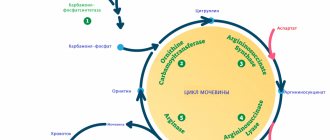Uric acid
Uric acid is the end product of the breakdown of nitrogen-containing compounds called purine bases, or purines. These substances are one of the main components of nucleic acids and are part of all cells of the body. During the natural death of old and damaged cells, as well as when consuming certain foods (red meat, offal, sausages and processed meats, legumes, beer), purines enter the liver, where they are converted into uric acid, which is released into the blood and excreted from the body in the urine. .
Elevated levels of uric acid in the blood (hyperuricemia) can cause gout, a disease associated with impaired metabolism of purine bases. With gout, uric acid crystals are deposited in the joints, which is accompanied by attacks of pain and decreased mobility, up to the complete impossibility of functioning of the joint. Excess uric acid salts can also precipitate in the kidneys, leading to stone formation.
Hyperuricemia can occur with excessive consumption of purine-rich foods and drinks, with massive cell death (for example, during the treatment of cancer), with severe metabolic syndrome, or under the influence of hereditary factors. With kidney pathology, there may be a delay in the excretion of uric acid from the body.
In what cases is research usually prescribed?
A blood test for uric acid levels is prescribed for signs of arthritis, in the diagnosis of gout, as well as for the following conditions:
- To control uric acid levels in people undergoing chemotherapy or radiation therapy to treat tumors;
- To identify the causes of the formation and recurrence of kidney stones;
- To monitor the effectiveness of gout treatment.
What do the test results mean?
Hyperuricemia develops when excess uric acid is produced or the kidneys are unable to eliminate it. More research is needed to determine the causes of this condition.
Patients with diagnosed gout or urate (made up of uric acid) kidney stones should avoid foods high in purines and alcohol. Elevated uric acid levels can also be caused by stress, dieting, intense exercise, and rapid weight loss. In some patients, hyperuricemia may be asymptomatic for a long time and detected only during testing.
Test deadlines.
You can usually get results the very next day.
How to prepare for the analysis?
You should adhere to the general rules of preparation for taking blood from a vein. Detailed information can be found in the corresponding section of the article.
1. General blood test.
Before taking a general blood test, the last meal should be no earlier than 3 hours before the blood draw.
2. Biochemical blood test.
To determine cholesterol and lipoproteins blood is taken after a 12-14 hour fast. Two weeks before the study, it is necessary to discontinue drugs that lower blood lipid levels, unless the goal is to determine the lipid-lowering effect of these drugs.
To determine the level of uric acid in the days preceding the study, it is necessary to follow a diet: avoid eating foods rich in purines - liver, kidneys, limit meat, fish, coffee, tea as much as possible in the diet. Intense physical activity is contraindicated.
Blood donation for hormonal testing is carried out on an empty stomach (preferably in the morning; if this is not possible, 4-5 hours after the last meal in the afternoon and evening). On the eve of the test, high-fat foods should be excluded from the diet, and the last meal should not be large.
The results of hormonal studies in women of reproductive age are influenced by physiological factors associated with the stage of the menstrual cycle, therefore, when preparing for an examination for sex hormones, you should indicate the phase of the cycle and adhere to the recommendations of your doctor about the day of the menstrual cycle on which you need to donate blood.
Hormones of the reproductive system in women are tested strictly according to the days of the cycle:
- LH, FSH - 3-5 days;
- Estradiol - 5-7 or 21-23 days of the cycle;
- progesterone 21-23 days of the cycle.
- prolactin, 17-OH-progesterone,
- DHA sulfate, testosterone - 7-9 days.
- Blood for insulin and C-peptide is given strictly on an empty stomach in the morning. Thyroid hormones, insulin, C-peptide are given regardless of the day of the cycle.
In men, reproductive hormones are released in the morning (8-9 am).
Before donating blood for stress hormones (ACTH, cortisol) , you need to calm down, when donating blood, get distracted and relax, since any stress causes an unmotivated release of these hormones into the blood, which will lead to an increase in this indicator.
The requirements for donating blood when testing for infections are the same as when studying a hormonal profile. Blood is donated on an empty stomach (in the morning or 4-5 hours after the last meal in the afternoon and evening, and this last meal should not be heavy, and high-fat foods should be excluded from the diet the day before the test). The results of tests for the presence of infections depend on the period of infection and the state of the immune system, so a negative result does not completely rule out infection. In doubtful cases, it is advisable to re-test after 3-5 days.
A blood test for the presence of antibodies of the IgG, IgM, IgA classes to infectious agents should be carried out no earlier than 10-14 days from the moment of illness, since the production of antibodies by the immune system and the appearance of their diagnostic titer begins during this period. At an early stage of the disease, seroconversion occurs (absence of antibodies during the acute period of the disease).
Before donating blood for viral hepatitis , 2 days before the test, it is advisable to exclude citrus fruits, orange fruits and vegetables from the diet.
Before donating blood for coagulation studies, you must inform your doctor about taking anticoagulant medications.
Interference:
- Beta blockers, cisplatin, corticosteroids, cyclosporine, diazoxide, didanosine, diuretics, epinephrine, ethanol, ethambutol, filgrastim, fructose (iv), niacin (high doses), norepinephrine, pyrazinamide, salicylates (low doses), fluda-rabine, hydroxyurea, idarubicin, mechlorethamine, theophylline (iv).
- Acetogesamide, allopurinol, azathioprine, bishydroxycoumarin, chlorprothixene, clofibrate, contrast agents (diatrizoate, iodipamide, iopanoic acid, iopodate), ethacrynic acid (iv), fenofibrate, furosemide (iv), probenecid, salicylates (in high doses) .
Uric acid in a single urine sample
Uric acid in urine is an indicator of the excretion of uric acid from the body, the end product of purine base metabolism. The content of uric acid in urine is associated with kidney function, the activity of purine metabolism, dietary patterns (many purines in meat), and the effects of medications. The main indications for use: clinical signs of purine metabolism disorders in gout, tumor growth, blood and liver diseases.
The metabolic pathway of the breakdown of adenine and guanine (purine nucleotides that are part of DNA and RNA or supplied with food) in humans and primates ends with the formation of uric acid or allantoin in other mammals. Uric acid in urine reflects the breakdown of purine nucleotides (adenine, guanine) present in the body and their intake from food. The formation of uric acid and its excretion in humans occur at approximately equal rates in the absence of purines in food. It should be borne in mind that milk, eggs, and cheese contain few purines, while liver contains a large amount. It is believed that about 70% of uric acid is excreted in the urine. Normally (with a normal diet), the content of uric acid in urine is 250-750 mmol/l. Exceeding more than 800 mmol/L may indicate increased uric acid synthesis or a diet high in purines.
When eating regular food, about 0.7 g of uric acid is normally excreted in the urine daily and rarely falls below 0.5-0.6 g even in the absence of purines (adenosine, guanosine - found in DNA and RNA) in the food. A sharp increase (above 1 g per day) occurs when foods containing nucleoproteins (gland tissue) are consumed.
The ratio of uric acid concentration in urine to blood concentration is approximately 20. In the proximal tubule, uric acid is absorbed and secreted through a transport process carried out by a carrier. Unlike creatinine and urea, excess uric acid is excreted in the urine if its concentration is only slightly higher than normal.
Determining the excretion of uric acid in urine (quantitative analysis) in combination with determining its level in the blood facilitates the diagnosis of diseases accompanied by disturbances in its metabolism (such as leukemia, gout). Increased levels are observed in hepatitis, polycythemia and aspirin administration. Since uric acid/uric acid salts are poorly soluble, they can precipitate in the urine and lead to the formation of stones in the lower urinary tract.
The solubility of sodium salt of uric acid in human body fluids is 6.4 mg/ml. In gout, large amounts of sodium salts of uric acid are concentrated in the form of gouty deposits in the cartilage tissue. Its deposits lead to the formation of kidney stones, accompanied by their damage. The majority of all kidney stones consist of poorly soluble uric acid and its salts.
Uric acid in the blood serves as a criterion for assessing the severity of gout and its diagnosis.
Causes of excess uric acid
The causes of excess uric acid are:
- mass cell death (oncological diseases of the blood system, antitumor treatment);
- dietary overload, abuse of foods rich in purines;
- impaired renal function and slower excretion of sUA (chronic renal failure, glomerulonephritis, amyloidosis);
- excess production or acceleration of metabolism, utilization of purine bases (genetic defects of enzymes).
Hyperuricemia is also considered an indicator of chronic low-level inflammation. Elevated uric acid often accompanies obesity, insulin resistance, dyslipidemia, hyperglycemia (including diabetes mellitus).
Rare causes of excess uric acid include:
- acute heart failure,
- hemolytic and sickle cell anemia,
- hypothyroidism, parathyroidism,
- heavy metal poisoning (lead),
- Down syndrome.
Stress, intense physical activity, and rapid weight loss can lead to a false positive result.
Medicines that affect uric acid levels
Distortion of the real level of sUA is possible when taking certain medications:
Raise:
- anabolic steroids, adrenaline,
- a nicotinic acid,
- ethacrynic acid,
- vitamin C,
- cyclosporine, cisplatin, asparginase,
- small doses of acetylsalicylic acid, clopidogrel, thiazide diuretics,
- beta blockers,
- calcitriol,
- isoniazid, ethambutol,
- diclofenac, indomethacin, ibuprofen, piroxicam.
Demote:
- allopurinol,
- glucocorticoids,
- azathioprine estrogens,
- warfarin, spironolactone, amlodipine, verapamil, large doses of acetylsalicylic acid,
- chlorprothixene, levodopa, methyldopa,
- contrast agents,
- vinblastine, methotrexate,
- acetylcysteine,
- metamizole sodium (analgin).
MK in the blood is always higher in the morning.
Interpretation:
- Gout, renal failure, leukemia, myeloma, polycythemia, lymphoma, other disseminated tumors, toxicosis of pregnancy, psoriasis, glycogenosis type I, Lesch-Nyhan syndrome, Down syndrome, polycystic kidney disease. In combination with hyperlipidemia, obesity, arterial hypertension, atherosclerosis, diabetes mellitus, hypoparathyroidism, acromegaly, sarcoidosis, liver diseases.
- Konovalov-Wilson disease, Fanconi syndrome, some malignant neoplasms (Hodgkin's disease, myeloma, bronchogenic cancer), xanthinuria, syndrome of pathological secretion of antidiuretic hormone, diet poor in purines.
Sample result (PDF)
general characteristics
Uric acid is a product of the metabolism of purine bases that are part of nucleoproteins. It is formed during the breakdown of nucleic acids in the body and from products supplied with food. In the extracellular fluid it is present in the form of sodium salts in a concentration close to saturation, so crystallization of urates is possible. Uric acid excreted in urine reflects the intake of purines from food and the breakdown of endogenous purine nucleotides. Therefore, in healthy people, uric acid levels may increase with a high purine diet and decrease with a low-purine diet.









